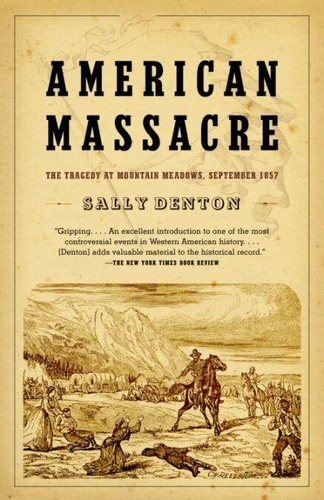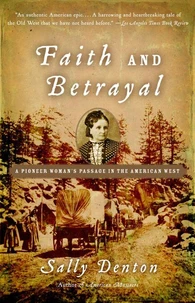American Massacre. The Tragedy at Mountain Meadows, September 1857
Par :Formats :
Disponible dans votre compte client Decitre ou Furet du Nord dès validation de votre commande. Le format ePub protégé est :
- Compatible avec une lecture sur My Vivlio (smartphone, tablette, ordinateur)
- Compatible avec une lecture sur liseuses Vivlio
- Pour les liseuses autres que Vivlio, vous devez utiliser le logiciel Adobe Digital Edition. Non compatible avec la lecture sur les liseuses Kindle, Remarkable et Sony
- Non compatible avec un achat hors France métropolitaine
 , qui est-ce ?
, qui est-ce ?Notre partenaire de plateforme de lecture numérique où vous retrouverez l'ensemble de vos ebooks gratuitement
Pour en savoir plus sur nos ebooks, consultez notre aide en ligne ici
- Nombre de pages352
- FormatePub
- ISBN978-0-307-42472-3
- EAN9780307424723
- Date de parution18/12/2007
- Protection num.Adobe DRM
- Taille2 Mo
- Infos supplémentairesepub
- ÉditeurVintage
Résumé
In September 1857, a wagon train passing through Utah laden with gold was attacked. Approximately 140 people were slaughtered; only 17 children under the age of eight were spared. This incident in an open field called Mountain Meadows has ever since been the focus of passionate debate: Is it possible that official Mormon dignitaries were responsible for the massacre? In her riveting book, Sally Denton makes a fiercely convincing argument that they were.
The author-herself of Mormon descent-first traces the extraordinary emergence of the Mormons and the little-known nineteenth-century intrigues and tensions between their leaders and the U. S. government, fueled by the Mormons' zealotry and exclusionary practices. We see how by 1857 they were unique as a religious group in ruling an entire American territory, Utah, and commanding their own exclusive government and army.
Denton makes clear that in the immediate aftermath of the massacre, the church began placing the blame on a discredited Mormon, John D. Lee, and on various Native Americans. She cites contemporaneous records and newly discovered documents to support her argument that, in fact, the Mormon leader, Brigham Young, bore significant responsibility-that Young, impelled by the church's financial crises, facing increasingly intense scrutiny and condemnation by the federal government, incited the crime by both word and deed.
Finally, Denton explains how the rapidly expanding and enormously rich Mormon church of today still struggles to absolve itself of responsibility for what may well be an act of religious fanaticism unparalleled in the annals of American history. American Massacre is totally absorbing in its narrative as it brings to life a tragic moment in our history.
The author-herself of Mormon descent-first traces the extraordinary emergence of the Mormons and the little-known nineteenth-century intrigues and tensions between their leaders and the U. S. government, fueled by the Mormons' zealotry and exclusionary practices. We see how by 1857 they were unique as a religious group in ruling an entire American territory, Utah, and commanding their own exclusive government and army.
Denton makes clear that in the immediate aftermath of the massacre, the church began placing the blame on a discredited Mormon, John D. Lee, and on various Native Americans. She cites contemporaneous records and newly discovered documents to support her argument that, in fact, the Mormon leader, Brigham Young, bore significant responsibility-that Young, impelled by the church's financial crises, facing increasingly intense scrutiny and condemnation by the federal government, incited the crime by both word and deed.
Finally, Denton explains how the rapidly expanding and enormously rich Mormon church of today still struggles to absolve itself of responsibility for what may well be an act of religious fanaticism unparalleled in the annals of American history. American Massacre is totally absorbing in its narrative as it brings to life a tragic moment in our history.
In September 1857, a wagon train passing through Utah laden with gold was attacked. Approximately 140 people were slaughtered; only 17 children under the age of eight were spared. This incident in an open field called Mountain Meadows has ever since been the focus of passionate debate: Is it possible that official Mormon dignitaries were responsible for the massacre? In her riveting book, Sally Denton makes a fiercely convincing argument that they were.
The author-herself of Mormon descent-first traces the extraordinary emergence of the Mormons and the little-known nineteenth-century intrigues and tensions between their leaders and the U. S. government, fueled by the Mormons' zealotry and exclusionary practices. We see how by 1857 they were unique as a religious group in ruling an entire American territory, Utah, and commanding their own exclusive government and army.
Denton makes clear that in the immediate aftermath of the massacre, the church began placing the blame on a discredited Mormon, John D. Lee, and on various Native Americans. She cites contemporaneous records and newly discovered documents to support her argument that, in fact, the Mormon leader, Brigham Young, bore significant responsibility-that Young, impelled by the church's financial crises, facing increasingly intense scrutiny and condemnation by the federal government, incited the crime by both word and deed.
Finally, Denton explains how the rapidly expanding and enormously rich Mormon church of today still struggles to absolve itself of responsibility for what may well be an act of religious fanaticism unparalleled in the annals of American history. American Massacre is totally absorbing in its narrative as it brings to life a tragic moment in our history.
The author-herself of Mormon descent-first traces the extraordinary emergence of the Mormons and the little-known nineteenth-century intrigues and tensions between their leaders and the U. S. government, fueled by the Mormons' zealotry and exclusionary practices. We see how by 1857 they were unique as a religious group in ruling an entire American territory, Utah, and commanding their own exclusive government and army.
Denton makes clear that in the immediate aftermath of the massacre, the church began placing the blame on a discredited Mormon, John D. Lee, and on various Native Americans. She cites contemporaneous records and newly discovered documents to support her argument that, in fact, the Mormon leader, Brigham Young, bore significant responsibility-that Young, impelled by the church's financial crises, facing increasingly intense scrutiny and condemnation by the federal government, incited the crime by both word and deed.
Finally, Denton explains how the rapidly expanding and enormously rich Mormon church of today still struggles to absolve itself of responsibility for what may well be an act of religious fanaticism unparalleled in the annals of American history. American Massacre is totally absorbing in its narrative as it brings to life a tragic moment in our history.





